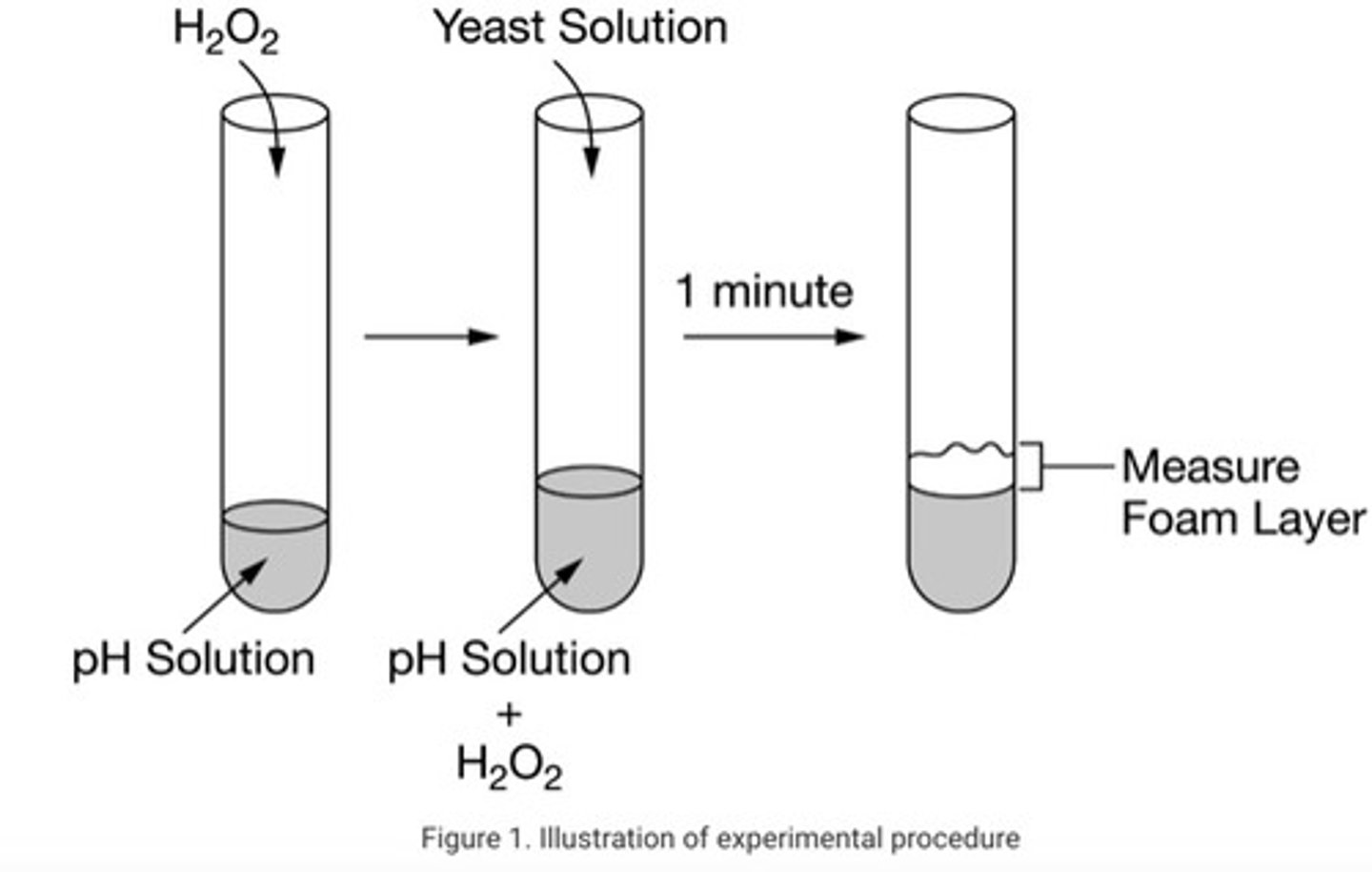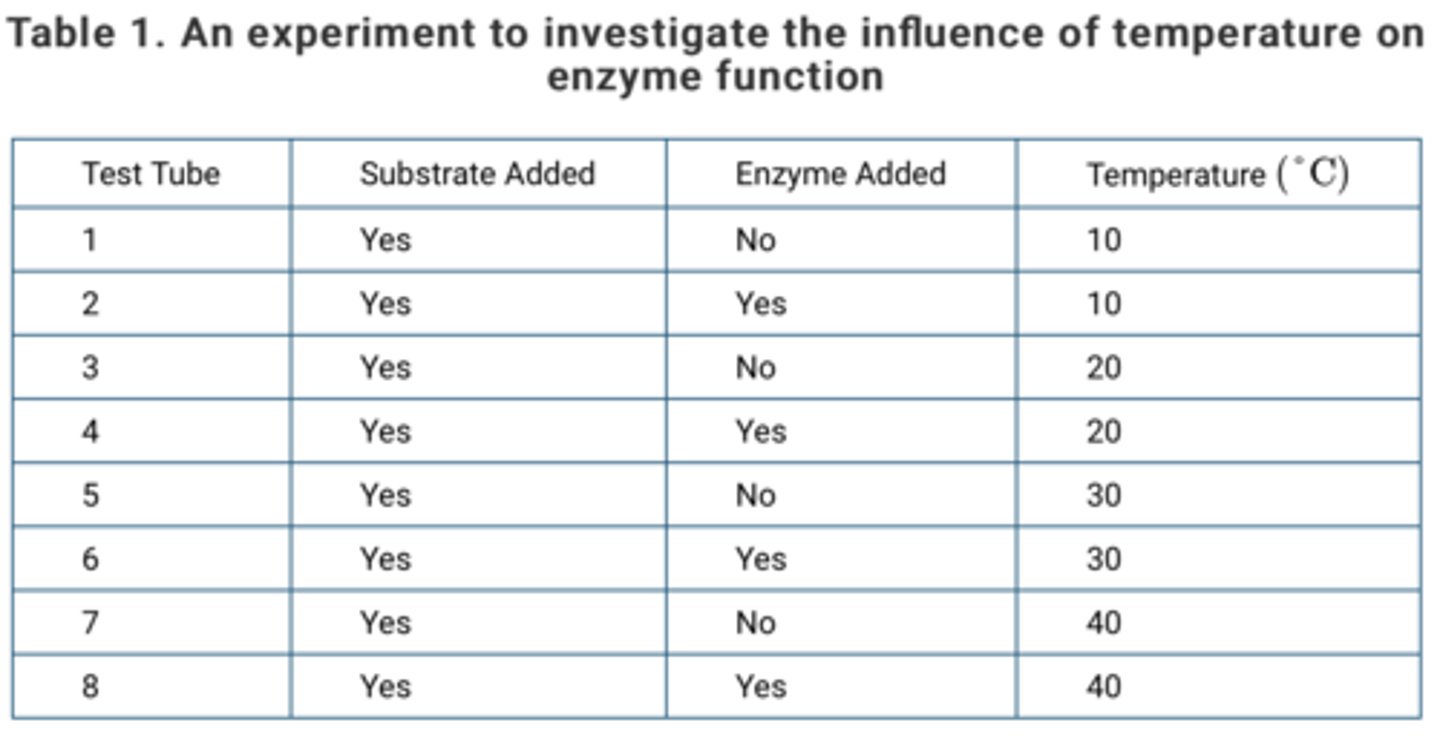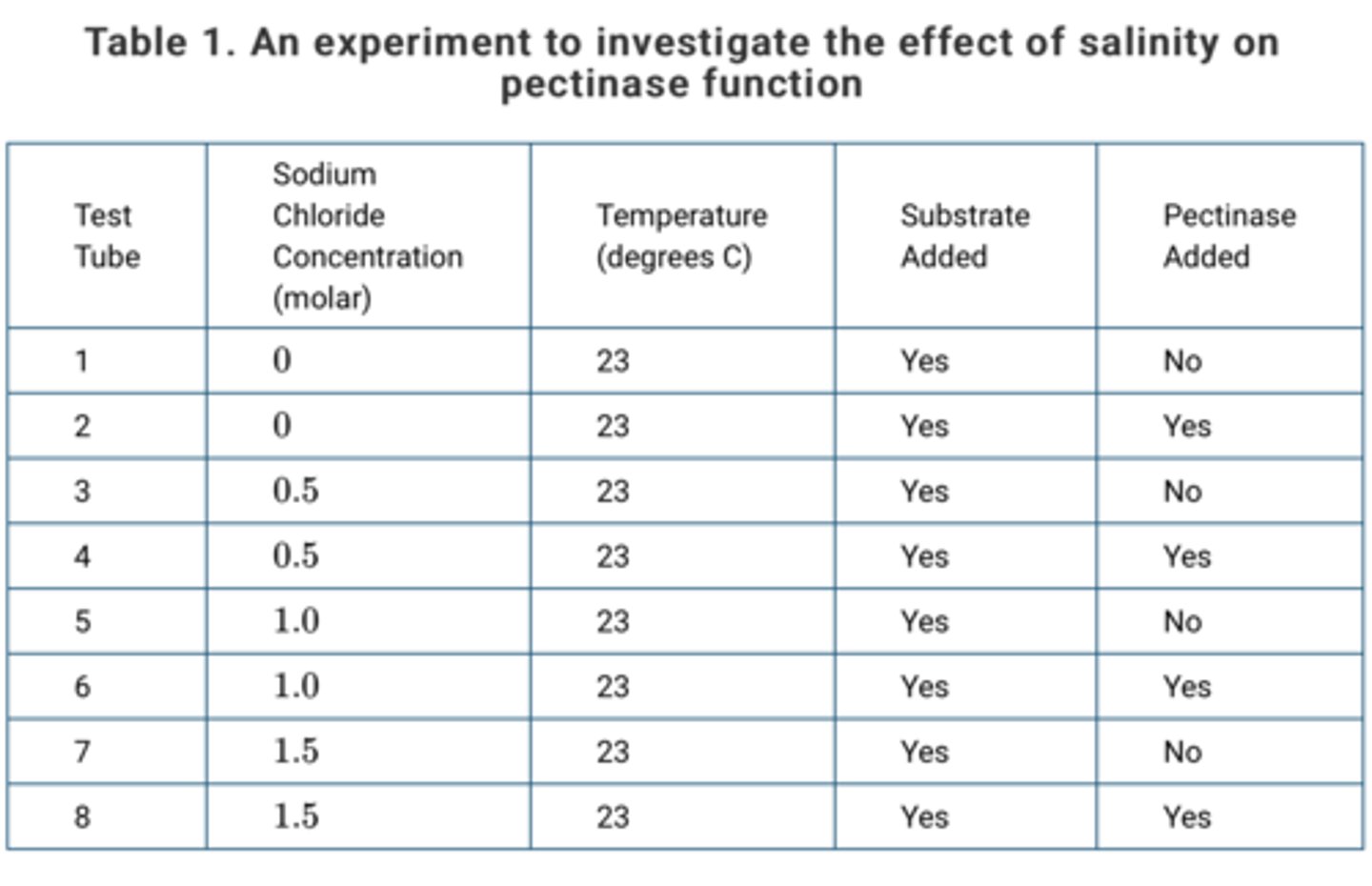AP Biology - Unit 3 Progress Check: MCQ
1/20
There's no tags or description
Looks like no tags are added yet.
Name | Mastery | Learn | Test | Matching | Spaced |
|---|
No study sessions yet.
21 Terms
Researchers investigated the influence of environmental pH on the activity of peroxidase, an enzyme that catalyzes the conversion of hydrogen peroxide to water and oxygen gas. In an experiment, the researchers added a hydrogen peroxide solution containing guaiacol to several identical test tubes and adjusted the solution in each test tube to a different pH. The researchers included the guaiacol because it caused the solutions to change color as the reactions proceeded, which the researchers relied on for measuring reaction rates. Finally, the researchers added the same amount of peroxidase to each test tube and measured the rate of each reaction at 23°C. The results of the experiment are represented in Figure 1.
Based on Figure 1, which of the following statements best predicts the effect that a change from a moderately acidic environment (pH near 6) to a basic environment will have on peroxidase activity?
Answer (A): Peroxidase activity will decrease.
Explanation: Based on Figure 1, peroxidase's optimal pH is 5. A change from a moderately acidic environment (pH near 6) to a basic environment (pH above 7) will result in a decrease in peroxidase activity.
Which of the following actions will provide a negative control for the investigation?
Answer (D): Repeating the experiment using heat-denatured peroxidase
Explanation: A negative control is a group in which no response is expected. It is the opposite of the positive control, in which a known response is expected. Heat-denatured peroxidase will be inactive. Repeating the experiment using heat-denatured peroxidase will allow the researcher to measure reaction rates in the presence of inactive peroxidase.

One of the researchers proposes using oxygen gas production to measure reaction rates. Which of the following statements best justifies the use of the proposed modification as a way of creating an appropriate control for the investigation?
Answer (C): The experiment can be repeated without guaiacol, which will reveal the effect of guaiacol on the reaction rates.
Explanation: In the original experiment, the researchers used guaiacol as a reaction indicator. By using oxygen gas production to measure reaction rates, the researchers no longer need the guaiacol and can repeat the experiment without it, which will reveal the effect of guaiacol on the reaction rates.
Aminolevulinate dehydratase (ALAD) is an enzyme that relies on zinc as a cofactor. A zinc ion binds to the ALAD active site, where it forms favorable interactions with the side chains of three amino acids. Researchers have found that substituting a lead ion for a zinc ion in the ALAD active site causes inhibition of ALAD.
Which of the following statements best helps explain how the lead ion causes inhibition of ALAD?
Answer (C): It changes the three-dimensional structure of the active site so that ALAD is no longer compatible with its substrate.
Explanation: The substitution of a lead ion for a zinc ion most likely changes the three-dimensional structure of the ALAD active site. The three-dimensional structure of the active site plays an important role in the compatibility between an enzyme and its substrate. Changing the structure of the active site will likely interfere with enzyme function by disrupting the enzyme-substrate interaction.
Acetylcholinesterase (AChE) is a protein that catalyzes the conversion of acetylcholine to acetate and choline. When the concentration of AChE in an aqueous solution is held constant, the rate of the reaction catalyzed by AChE increases with increasing concentrations of substrate. At low concentrations of acetylcholine, a small increase in the substrate concentration results in a large increase in the reaction rate. At high concentrations of acetylcholine, however, a large increase in the substrate concentration results in only a small increase in the reaction rate.
Which of the following statements correctly explains the observed effect of the acetylcholine concentration on the rate of the enzyme-catalyzed reaction?
Answer (A): The active site of AChE is specific for acetylcholine, and only one substrate molecule can occupy the active site at a time.
Explanation: Acetylcholine is the substrate for AChE, and since the shape and charge of the active site is specific for acetylcholine, only one substrate molecule can occupy the active site at a time. Therefore, at high concentrations of acetylcholine, AChE becomes saturated with substrate. When an enzyme is saturated with substrate, adding more substrate to the solution will not lead to an observable increase in the reaction rate.
A researcher proposes a model to explain how enzyme-substrate interactions determine enzyme specificity. The model is based on the idea that substrate molecules form favorable interactions with the amino acid side chains in an enzyme's active site.
Based on the model, which of the following statements best explains an enzyme's specificity for a particular substrate molecule?
Answer (D): A molecule with negative charges interacts with positively charged side chains in the enzyme's active site.
Explanation: Because opposite charges attract, a molecule with negative charges will form favorable interactions with positively charged side chains in an enzyme's active site. Based on the model, the favorable interactions helps explain the enzyme's specificity for the molecule as a substrate.
Catalase is an enzyme found in yeast cells that facilitates the chemical breakdown of hydrogen peroxide to water and oxygen gas. An experiment was conducted to determine the effect of pH on catalase function. Five buffer solutions of varying pH (2, 4, 6, 8, and 10) were prepared and added to separate test tubes. Hydrogen peroxide (H2O2) was added to each test tube. Yeast was added, and the reactions were timed. After 1 minute the amount of oxygen gas released was determined by measuring the foam layer produced in each test tube. Figure 1 illustrates the experimental setup.
A set of five additional test tubes were prepared and used as controls. Which of the following best describes the contents expected to be contained in one of the five control test tubes?
Answer (A): pH 4 buffer solution and hydrogen peroxide only
Explanation: Since the experiment is studying the effect of pH on catalase in yeast, the control set should determine what would happen without yeast present. Each test tube in the control set should contain hydrogen peroxide and one of the pH solutions.

A student designs an experiment to investigate the influence of temperature on enzyme function. The student's plan is presented in Table 1.
Which test tubes are controls in the experiment?
Answer (C): Test tubes 1, 3, 5, and 7
Explanation: The test tubes that do not contain the enzyme are negative controls in the experiment. The negative controls help confirm that the results of the experiment are related to enzyme function and not some other factor.

A researcher designs an experiment to investigate whether soil bacteria trigger the synthesis of defense enzymes in plant roots. The design of the experiment is presented in Table 1. For each group in the experiment, the researcher will determine the average rate of change in the amount of defense enzymes in the roots of the seedlings.
Which of the following statements best helps justify the inclusion of group 2 as one of the controls in the experiment?
Answer (A): It will show whether the changes observed in group 1 depend on the metabolic activity of soil bacteria.
Explanation: The seedlings in group 1 will be treated with a solution that contains actively reproducing bacteria, which will be metabolically active. In contrast, the seedlings in group 2 will be treated with a solution that contains heat-killed bacteria, which will be metabolically inactive. The researcher will be able to compare the results for group 1 with those for group 2. The comparison will help the researcher determine whether the changes observed in group 1 depend on the metabolic activity of soil bacteria
Pectinase is a protein that catalyzes the breakdown of pectic polysaccharides in plant cell walls. A researcher designs an experiment to investigate the effect of salinity on the ability of pectinase to lower the activation energy of the reaction involved. The design of the experiment is presented in Table 1. For each test tube, the researcher will measure the amount of product formed over 20 minutes.
Which of the following statements best helps justify the inclusion of test tube 5 in the experiment?
Answer (C): It will act as a control for test tube 6 by showing the effect of the presence or absence of the enzyme.
Explanation: Test tube 5 will act as a control for test tube 6. The solutions in test tubes 5 and 6 are nearly identical except that the researcher will add pectinase to test tube 6 but not to test tube 5. A comparison of the data for test tubes 5 and 6 will show the effect of the presence or absence of the enzyme.

Researchers investigated the effect of urea on the three-dimensional structure of a certain enzyme. The researchers dissolved the enzyme in an aqueous buffer solution and added urea to the solution. The enzyme did not appear to have a secondary or tertiary structure. The researchers carefully removed the urea from the solution and determined that the enzyme had the original secondary and tertiary structure again.
Based on the results of the experiment, which of the following statements best predicts the effect of urea on the enzyme's function?
Answer (A): Function will be disrupted by adding the urea and regained by removing the urea.
Explanation: Based on the information, adding the urea denatures the enzyme, which will disrupt the enzyme's function by disrupting the active site. In contrast, removing the urea causes the enzyme to refold, which will restore the active site and the enzyme's function.
In an experiment, a researcher prepares a reaction mixture by dissolving a substance in a buffered solution. The substance is the substrate of a certain enzyme. The researcher adds a small amount of the enzyme to the reaction mixture and measures the amount of product that is formed over time. The data are represented in Figure 1.
Which of the following best predicts the immediate result of adding more substrate to the reaction mixture at the point indicated by the arrow in Figure 1?
Answer (C): The amount of product will increase until the reaction reaches its equilibrium point or until the substrate is used up by the reaction.
Explanation: The graph shown in Figure 1 indicates that the amount of product became constant as a consequence of the reaction reaching its equilibrium point or as a consequence of the substrate being used up. Adding more substrate will likely result in an increase in the amount of product because the reaction catalyzed by the enzyme will convert the added substrate into product.
European flycatchers feed caterpillars to their hatchlings. Graph 1 shows the average dates of hatching and fledging (leaving the nest), and the biomass of the caterpillars between early May (when flycatcher young hatch) and June (when fledging of young occurs).
Based on the data, scientists claim that the reproductive behavior of European flycatchers is influenced by the availability of energy sources. Which of the following statements best justifies this claim?
Answer (A): Young European flycatchers hatch from eggs when caterpillar biomass is available for the young birds to consume and convert into energy for growth.
Explanation: The date of European flycatchers hatching matches the date when the peak biomass of caterpillars is available, ensuring better odds of survival for young flycatchers.

A researcher claims that the incorporation of carbon dioxide into organic molecules during photosynthesis does not violate the second law of thermodynamics.
Which of the following statements best helps justify the researcher's claim?
Answer (D): The total system that includes photosynthetic organisms and the Sun becomes less ordered over time.
Explanation: Because the total system that includes photosynthetic organisms and the Sun becomes less ordered over time, the incorporation of carbon dioxide molecules into organic molecules that occurs during photosynthesis does not violate the second law of thermodynamics.
Brown fat is a type of fat tissue found in hibernating mammals. Inside the mitochondria of these fat tissue cells, these mammals have an uncoupling protein embedded in the inner mitochondrial membrane. This uncoupling protein allows hydrogen ions to leak from the intermembrane space back into the mitochondrial matrix. Figure 1 shows details of the processes in the inner mitochondrial membrane.
Which of the following statements provides reasoning that supports the claim that brown fatty tissue keeps an animal warm?
Answer (B): The uncoupling protein in this tissue reduces the proton gradient across the membrane and thus produces heat to warm the animal without ATP production.
Explanation: The uncoupling protein causes a reduction in the proton gradient across the inner mitochondrial membrane because protons constantly leak into the matrix. Heat energy is released as the protons move, but less ATP is made because of the decreased concentration of hydrogen ions available to move across ATP synthase.

A researcher claims that spinach leaves capture the most energy from light waves in the range of 500 nm to 600 nm. To test the claim, the researcher will place spinach leaves in separate chambers and expose the leaves to different wavelengths of light. For each chamber, the researcher will measure the amount of oxygen gas (O2) that is produced in one hour.
Which of the following graphs best represents data from the experiment that will support the researcher's claim?
Answer (B):
Explanation: The high levels of O2 produced at wavelengths between 500 nm and 600 nm directly support the researcher's claim. Because oxygen is produced as a by-product of photosynthesis, a greater level of oxygen production indicates a greater level of energy-capture from light.

A researcher claims that the initial rise of oxygen in Earth's early atmosphere, which occurred approximately 2.3 billion years ago, resulted from the metabolic activity of prokaryotic organisms. The claim is based on an interpretation of the geochemical and fossil evidence represented in Figure 1.
Which of the following types of evidence will best support the researcher's claim?
Answer (D): Evidence that the cyanobacteria produced oxygen as a by-product of photosynthesis
Explanation: Based on Figure 1, cyanobacteria appear in the fossil record before the rise of oxygen in Earth's early atmosphere. The researcher's claim will be supported by evidence that the cyanobacteria that were on Earth more 2.3 billion years ago produced oxygen as a by-product of photosynthesis. Also, cyanobacteria are prokaryotes, which is consistent with the researcher's claim.
A researcher claims that a certain herbicide suppresses plant growth by inhibiting chloroplast function. To test the claim, the researcher treats isolated chloroplasts with increasing concentrations of the herbicide. The data from the experiment are presented in Table 1.
Which of the following statements best clarifies how the data support the researcher's claim?
Answer (B): ATP synthase activity depends on a proton gradient across the thylakoid membrane.
Explanation: The results of the experiment indicate that ATP production in the isolated chloroplasts decreases with increasing concentrations of the herbicide. The data also show that the decrease in ATP production is associated with a decrease in the pH difference across the thylakoid membrane. The pH difference is created by a proton gradient, which ATP synthase relies on to produce ATP.
A researcher claims that genetic variation provides organisms with the ability to survive and reproduce in different environments. To support the claim, the researcher makes the following observation: bacteria that contain plasmids (small DNA molecules) are resistant to a wider range of antibiotics than are bacteria that contain no plasmids.
Which of the following statements best establishes a connection between the observation and the researcher's claim?
Answer (D): Some plasmids contain antibiotic resistance genes.
Explanation: Because some plasmids contain antibiotic resistance genes, bacteria that contain plasmids are more likely to be resistant to antibiotics than are bacteria that do not contain plasmids. The observation is evidence that genetic variation in the form of plasmids provides bacteria with the ability to survive and reproduce in different environments.
Phycobiliproteins are a complex of accessory pigments and proteins found in cyanobacteria but not in green algae. A researcher claims that the phycobiliprotein pigments in cyanobacteria allow the cyanobacteria to survive in certain aquatic niches better than green algae can.
Which of the following statements best justifies the researcher's claim?
Answer (D): The additional pigments absorb light at wavelengths that green algae cannot absorb; this may allow cyanobacteria to capture more light energy for photosynthesis than green algae can in certain areas.
Explanation: Since the phycobiliprotein pigments absorb light wavelengths not absorbed by green algae, cyanobacteria are able to better perform photosynthesis and survive in areas where there is insufficient light at the needed frequencies for green algae to survive.
A researcher claims that budding yeast are able to survive in different environments because they produce enzymes that allow them to use different molecules as sources of matter and energy.
Which of the following statements best helps justify the researcher's claim by providing a relevant example?
Answer (C): Yeast cells produce invertase, which is an enzyme that catalyzes the conversion of the disaccharide sucrose into glucose and fructose.
Explanation: The disaccharide sucrose is not transported efficiently into yeast cells. By producing the enzyme invertase, budding yeast can use the sucrose, glucose, and fructose in the surrounding environment as sources of matter and energy. As such, the production of invertase by budding yeast is a relevant example that will help justify the researcher's claim.